There’s a certain axiom when dealing with history, it comes from the reimaging Battlestar Galactica, all of this has happened before, all of this will happen again. The rise of the reform movement and the radicalisation of elements of the reform movement merely in response to extremism on the opposite end of the political spectrum. And yes this is where we get messy and political. While Upper Canada saw a great deal of expansion and improvement under the governorship of Sir Peregrine Maitland and Sir John Colborne, not all were happy with how the Colonial Parliament operated. These complaints were brought to light when Robert Gourlay began his crusade, and many felt the Constitutional Reform Society would die out after his exile in 1818. But it did not, the society continued to meet, often in secret. And it was not just disenfranchised farmers, some members of high-society joined in with the cause.
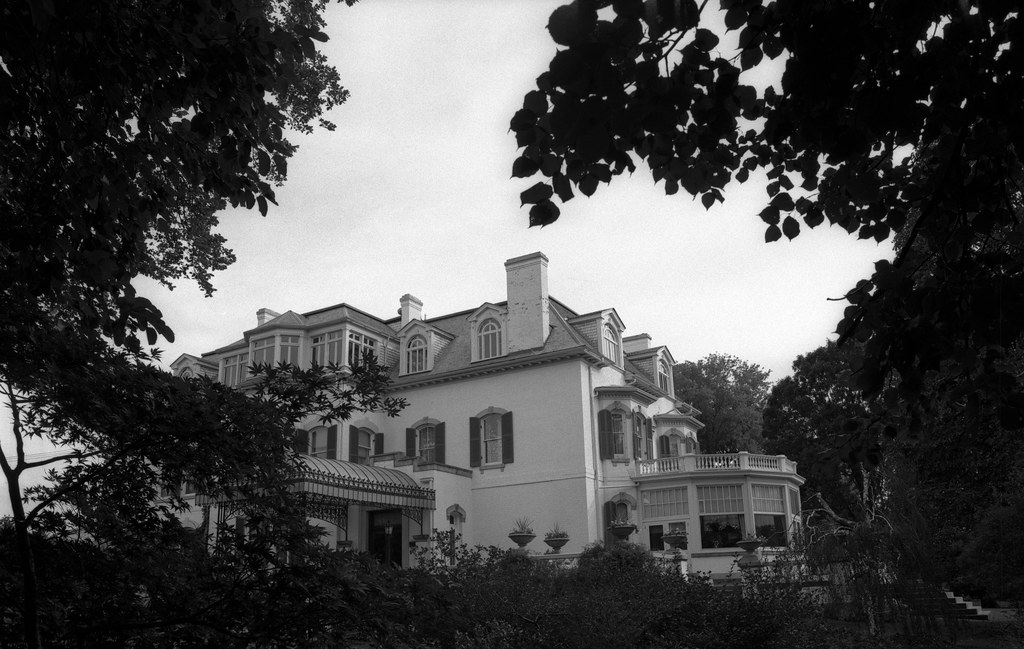
Mamiya m645 – Mamiya-Sekor C 45mm 1:2.8 N – Ilford FP4+ @ ASA-125 – Blazinal (1+25) 9:00 @ 20C
Men like Marshall Spring Bidwell, John Rolph, and William Warren Baldwin would continue to cause meeting in secret, but it became clear that the movement would have to come to light. But not all who supported the cause of reform were interested in politics. David Wilson, a loyalist by birth and a Quaker by Marriage, had split off the main group of Quakers in 1812 to form his sect, known as the Children of Peace or Davidites met in the village of Hope, today Sharron, Ontario. Among their use of music and ceremony in their worship, the Children of Peace believed in an equality society and in a province under autocratic rule and rule by elites they were a perfect match for the Reform movement. Wilson did not shy away from promoting the reform movement from the Temple of Peace where his followers met. And while Wilson could reach many, the Children of Peace never numbered more than 350 members; it would be the newspapers which allowed the reform movement to spread. Newspapers were not new in Upper Canada or British North America, however after Robert Gourlay they began to takes sides in Provincial Politics, with some supporting the Tories others the Reform Movement. Queenston businessman and Scottish immigrant, William Lyon MacKenzie, got into the newspaper game in 1824 with the founding of the Colonial Advocate, and while not the largest, it certainly proved the loudest. MacKenzie saw the Colonial Advocate as a way to tell the public the facts and let them come to the best option for who to vote for in the upcoming Provincial elections. Several reform candidates were up for election to the Legislative Assembly, among them William Warren Baldwin and Marshall Spring Bidwell. The reform movement did not want independence; they wanted change and some level of self-determination and freedom from the ruling elite who could control the direction of the government despite the direction desired by the elected Assembly. An idea of a government responsible to the people rather than the powers in London. Offering his aid towards this goal was John Rolph, one of the first teaching doctors in Upper Canada, who in a letter penned to Bidwell offered any help in removing the influence of the Family Compact and the evil they wrought on the province. Together the three reformers won their seats and gave voice to the reform movement in the Assembly, but the change could not happen overnight.
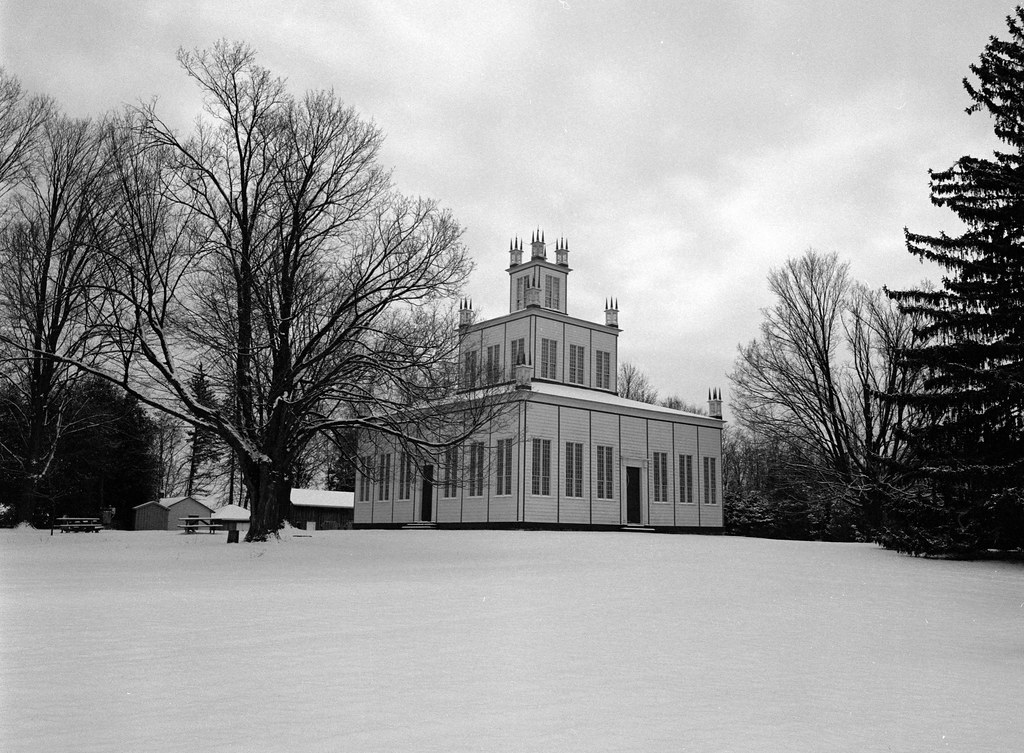
Mamiya m645 – Mamiya-Sekor C 45mm 1:2.8 N – Ilford HP5+ @ ASA-400 – Kodak HC-110 Dil. B 5:00 @ 20C
Originally based out of Queenston, MacKenzie quickly realised to influence political views and keep an eye on the political machinations of the Province, MacKenzie relocated his operations to York (Toronto). And while he had no desire to run for office, he kept an ear on the reform movement and knew that they were toothless. The Tories, those who were allied with the Family Compact held sway in all three levels of the Provincial Parliament. Not to mention the governor who both held power over the entire system and in the pocket of the Family Compact. Most of the Reform Movement desired change within the rules, MacKenzie only saw the Family Compact as a force to topple and began to print all kinds of vitriol, anyone connected to the compact could face all types of attack in the Colonial Advocate. But the cost of running the Colonial Advocate and the lack of subscription income forced MacKenzie to close up shop in 1826 and flee to the United States to escape his creditors. Taking advantage of his absence a group of youth, young men who were sons of members of the Compacts broke into the shuttered office. They stole, smashed, and vandalised. Most importantly the lead typesets were taken and tossed into Toronto harbour. Witnesses would stand by watching but not doing anything, and while the young men faced arrest. Chief Justice John Beverly Robinson made a personal point to preside over their trial. Justice Robinson stood as the leader of the Family Compact and often found himself attacked by MacKenzie and let the men go without charge. When MacKenzie heard this he rushed back to Upper Canada and sued to young men, refusing to take an out of court settlement. With the aid of Marshall Spring Bidwell, he won his case, and a jury awarded compensation of ₤625, today ₤71,000. Enough money to settle his debts and restart the Colonial Advocate. But his time in the United States had changed his views enough to send even his old allies running.

Mamiya m645 – Mamiya-Sekor C 45mm 1:2.8 N – Ilford FP4+ @ ASA-100 – Kodak D-23 (Stock) 6:00 @ 20C
Those who allied themselves with the Reform movement often found their efforts to expand their self-worth bogged down in procedure or denied. Whereas with an alliance with the Compact would bring an easing of the bureaucratic paperwork and the opening of certain doors. There’s no better example than William Chisholm. Chisholm, while a loyalist, had been an agent for the Colonial Advocate and had been elected in 1820 to the Assembly as a Reform candidate After MacKenzie became a keen supporter of the American Republic, he realised that his alignment with the Reform movement was only hurting his advancement in Upper Canada. His requests for land purchases often denied and his desire to continue to serve in the militia as an office. That all changed when he decided to seek reelection as a Tory. His shift in alliance changed his fortune. His request to purchase land at the mouth of the Sixteen Mile Creek would be approved, as was an appointment of Colonel in the Gore Militia. The village of Oakville sprung up, a shipyard, post office and several small homes were laid out and saw construction. Chisholm while he did not become a member of the Family Compact, but he did use his influence to help a friend, Allan Napier MacNab gain a commission in the Gore Militia and a land purchase on Burlington Heights, MacNab would become a member of the Compact. But the Tory hold on the Assembly could not last for long as the population of the Province saw a change with the Canal Projects of the late 1820s, Irish, Scottish, and others arrived in the Province seeking work. These men did not hold a strong loyalty to the Crown and often were non-Anglican. Not to mention the population of the province were shifting in loyalty to Upper Canada rather than England. It also helped that David Wilson hosted a convention to choose men to run for the Assembly that could win their seats easily for the reform movement. MacKenzie would stand for a seat in the York District. Specifically the area today made up of the historic villages which make up Mississauga today. Despite his running for public office, he continued his attacks, going so far as to publish a list of thirty men, who he named as the Family Compact. In reality, the membership in the Compact numbered only ten men, although every man on the list owed their power, wealth and standing to the Compact.

Mamiya m645 – Mamiya-Sekor C 150mm 1:3.5 N – Ilford FP4+ @ ASA-100 – Kodak D-23 (Stock) 6:00 @ 20C
Many felt that MacKenzie’s methods were low brow and some mainline reformers denounced the more radical views of MacKenzie. MacKenzie and a majority of Reformers won their seats. Some expected MacKenzie elected as speaker, the head of the Assembly, that honour went to Marshall Spring Bidwell. And while Bidwell did not agree with MacKenzie’s views, he planned to use MacKenzie’s determination to his gain. MacKenzie would head up several committees investigating everything, banks, land use, even the construction of the Welland Canal. And while the Assembly was free to examine all they wanted, fixing the issues, they found proved impossible, the Council, Executive, even the Governor vetoed them without question. MacKenzie’s efforts to reform the system took him to the United States, where he met with and discussed government with the recently elected President Andrew Jackson. There were two institutions in the United States that attracted MacKenzie the first was the power of the President to appoint allies to positions of power within the government the other was the Banking system. The irony remained that the power of patronage, as it was called in Upper Canada proved a sticking point to MacKenzie, he disliked it because he couldn’t appoint his friends. The trip helped tip MacKenzie over the edge, and he began to promote a more American style of government both in the Assembly and in the Colonial Advocate.
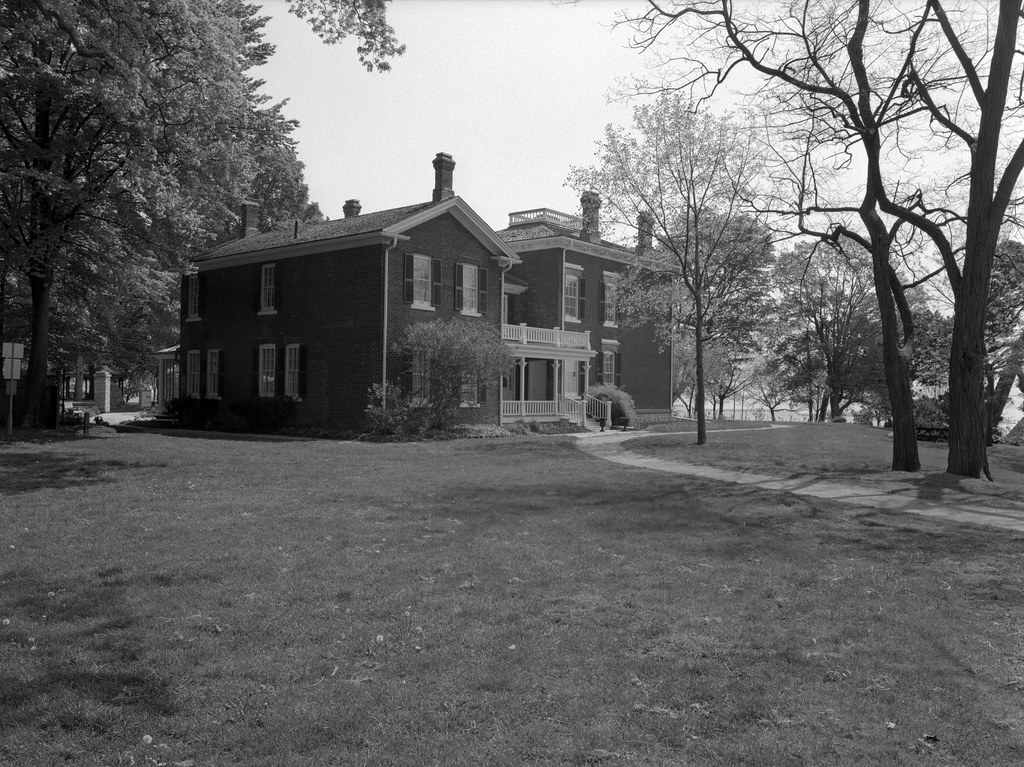
Mamiya m645 – Mamiya-Sekor C 45mm 1:2.8 N – Ilford FP4+ @ ASA-100 – Kodak D-23 (Stock) 6:00 @ 20C
The death of King George IV on the 26th of June, 1830 saw all Parliaments across the Empire dissolve and open elections called. But the reformers now found themselves at a disadvantage. Sir John Colborne and the Tories had orchestrated a carefully controlled immigration plan using their control over the Canada Company and throughout the last two years arranged for an influx of English Anglicans to populate the newly opened areas of the Province. These new arrivals returned the balance to the loyalist views towards England rather than Upper Canada. And while the elections returned a Tory majority to the assembly, several Reformers won their seats, among them William Lyon MacKenzie, and other men who supported his more radical views. MacKenzie would make life difficult for the Tories, in what was once a quiet and mature chamber, he picked fights with anyone and everyone. He attacked men in person and through the Colonial Advocate. But it was not just in Parliament; he became a nuisance in church eventually being forced to leave St. James Anglican Cathedral and St. Andrew’s Presbyterian Church. The Tory Majority quickly drew up a bill to expel MacKenzie from his seat, and the motion passed with ease. MacKenzie’s response would be vicious, he went directly to Governor Colborne demanding the body be dissolved and new elections called. Colborne refused, so MacKenzie returned to his newspaper and continued his attacks. But what the Tories did not count on was the support MacKenzie carried in his district and easily won reelection. Before he could return to his seat, the Tories again expelled MacKenzie, with MacNab making a move this time around. The district rallied around MacKenzie who now played the martyr card, so the Tories arranged for their thugs, men of the Orange Order, to attack MacKenzie at any rally he spoke at. But again MacKenzie saw reelection, but rather than face the threat of violence he went into hiding.
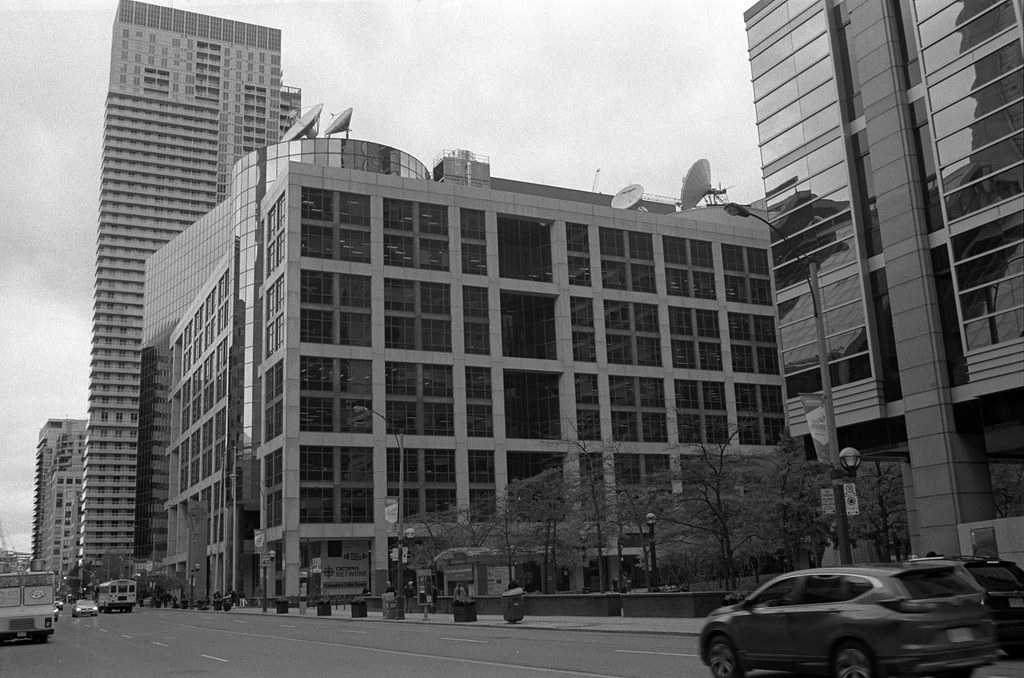
Nikon F6 – AF Nikkor 35mm 1:2D – Kodak Tri-X 400 @ ASA-400 – Kodak D-76 (1+1) 9:45 @ 20C
MacKenzie did not stop, and while he could not take his seat out of fear for his life, he instead went to London in 1832 to take his case directly to the Colonial Office. He took with him letters of support from members of the Reform movement in both Upper and Lower Canada. While in London he took time to meet with the members of the Reform Movement in London and watched the debate in the House of Commons of the passage of the Reform Bill. Surprisingly, MacKenzie found sympathy in the Colonial Office, who wanted to smooth over the turmoil they had seen in both Upper and Lower Canada. The Colonial Office listened and removed several members of the Compact from their posts, and authored a letter to Sir John Colborne to provide protection to MacKenzie and ensure he was allowed to take his seat. In his absence, he was again ejected from the Assembly and re-elected by acclamation as no one dared to run against him. He took the time to tour England and Scotland before returning to Canada in 1833 and retook his place in the Assembly. Knowing his position would be secure he continued to disrupt Parliament. But when the men who had been removed from their posts were returned to similar posts elsewhere, his mind had been made up. He knew that there was no hope to reform both the Colonial government; he changed the name of his paper to simply The Advocate.
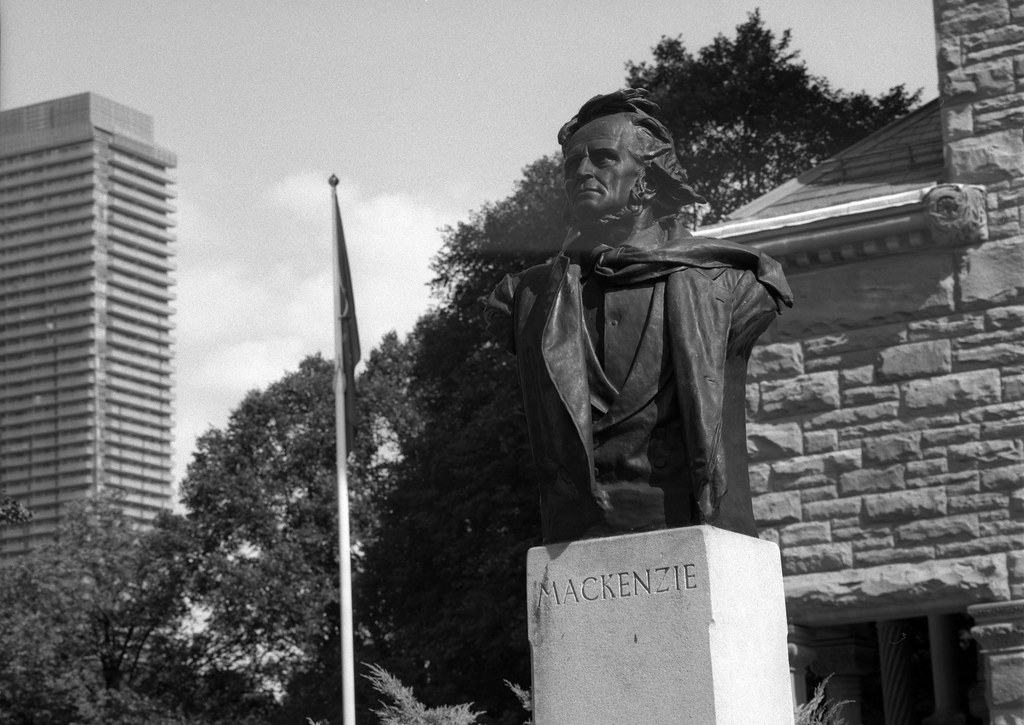
Mamiya m645 – Mamiya-Sekor C 150mm 1:3.5 N – Ilford FP4+ @ ASA-125 – Blazinal (1+25) 9:00 @ 20C
For William Lyon MacKenzie and his followers, the die was cast, their faith in the Colonial system had ended, and many began to speak of revolution and the creation of a Republic in Canada. However, none dared to speak it aloud yet. Such moves could spell death if discovered. I hate to leave you on a cliff hanger, but I wanted to give a brief outline to bring you towards 1835 where things started to go wrong. Today you can visit many of the sites connected to these early events. The home of William Warren Baldwin, known as Spadina House is one of Toronto’s least known museum, owing to the fact its neighbour is Casa Loma. While the original home burned down in 1835, it was rebuilt and purchased by James Austin in 1866. The home has been restored to how it appeared in the 1930s. I’ve had a chance to visit the museum with my wife (it was one of our early dates) although I had no idea of its significance at that point. William Chisholm’s Oakville is a thriving community, and the historic harbour remains an active marina, and his family continued as prominent members of the community well after his death in 1842. His son’s home, Erchless completed in 1858 now serves as the Community Museum. The nearby park and residential area are home to historic homes that date back to the community’s founding. The Third Parliament Building saw continued use throughout the remainder of the 1830s, occasional use as the Parliament for the United Provinces of Canada and even as home to the Ontario Parliament after Confederation in 1867. It was demolished, and today the site is occupied by the CBC Broadcast Centre and Simcoe Park in Downtown Toronto. William Lyon MacKenzie’s home and Printery in Queenston, Ontario lay in ruins for many years, but in the early 1990s was restored and today is home to a museum dedicated to MacKenzie and the printing industry, they even have the oldest functioning printing press in Canada. And one I need to make a point to visit this summer. Overall these early stumbling steps showed how small actions could cause major problems, and that polarisation in politics is nothing new.